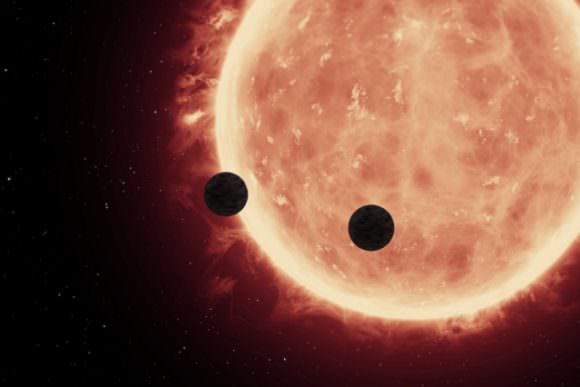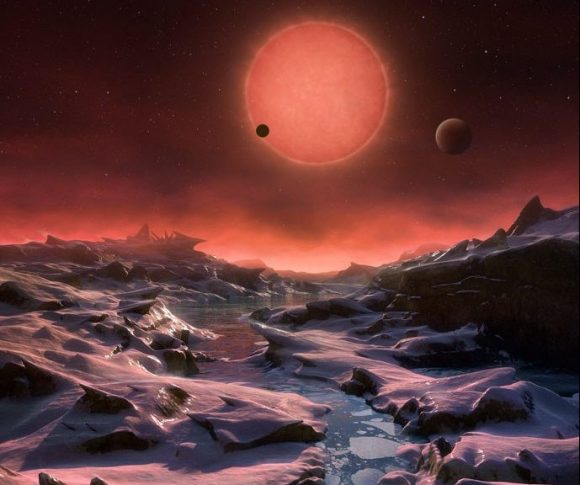Proxima b is the subject of a lot interest these days. And why not? As the closest extrasolar planet to our Solar System, it is the best shot we have at studying exoplanets up close in the near future. However, a recent study from the University of Marseilles indicated that, contrary to what many hoped, the planet may be a “water world” – i.e. a planet where up to half of its mass consists of water.
And now, researchers from the University of Bern have taken this analysis a step further. Based on their study, which has been accepted for publication in the journal Astronomy and Astrophysics (A&A), they have determined that the majority planets that form within the habitable zones of a red dwarf star may be water worlds. These findings could have drastic implications for the search for habitable exoplanets around red dwarf stars.
The research was conducted by Dr. Yann Alibert from the National Centers for Competence in Research (NCCR) PlanetS center and Prof. Willy Benz from the Center of Space and Habitability (CSH). Both of these institutions, which are located at the University of Bern, are dedicated to understanding planetary formation and evolution, as well as fostering a dialogue with the public about exoplanet research.

For the sake of their study, titled “Formation and Composition of Planets Around Very Low Mass Stars“, Alibert and Benz carried out the first computer simulation designed to examine the formation of planets around stars that are ten times less massive than our Sun. This involved creating a model that included hundreds of thousands of identical low-mass stars, which were then given orbiting protoplanetary disks of dust and gas.
They then simulated what would happen if planets began to form from the accretion of these disks. For each, they assumed the existence of ten “planetary embryos” (equal to the mass of the Moon) which would grow and migrate over time, giving rise to a system of planets.
Ultimately, what they found was that the planets orbiting within the habitable zone of their parent star would likely to be comparable in size to Earth – ranging from 0.5 to 1.5 times the radius of Earth, with 1 Earth radii being the average. As Dr. Yann Alibert explained to Universe Today via email:
“In the simulations we have considered here, it appears that the majority of the mass (more than 99%) is in the solids. [W]e therefore start with a protoplanetary disk that is made of solids and gas and 10 planetary embryos. The solids in the disk are planetesimals (similar to present day asteriods, around 1 km in size), that can be dry (if they are located in the hot regions of the protoplanetary disk) or wet (around 50% per mass of water ice, if they are in the cold regions of the disk). The planetary embryos are small bodies, whose mass is similar to the moon mass. We then compute how much of the disk solids are capture by the planetary embryos.”

In addition, the simulations produced some interesting estimates on how much of the planets would consist of water. In 90% of cases, water would account for more than 10% of the planets’ mass. Compare that to Earth, where water covers over 70% of our surface, but makes up only about 0.02% of our planet’s total mass. This would mean that the exoplanets would have very deep oceans and a layer of ice at the bottom, owing to the extreme pressure.
Last, but not least, Alibert and Benze found that if the protoplanetary disks that these planets formed from lived longer than the models suggested, the situation would be even more extreme. All of this could be dire news for those hoping that we might find ET living next door, or that red dwarf stars are the best place to look for intelligent life.
“The fact that many planets are water rich could have potentially very strong (and negative) consequence on the habitability of such planets,” said Dr. Alibert. “In fact, we already showed in other articles (Alibert et al 2013, Kitzmann et al. 2015) that if there is too much water on a planet, this may lead to an unstable climate, and an atmosphere that could be very rich in CO2.”
However, Alibert indicates that these two studies were conducted based on planets that orbit stars similar to our Sun. Red dwarfs are different because they evolve much slower (i.e. the luminosity changes very slowly over time) and they are far more red than our Sun, meaning that the light coming from them has different wavelengths that will interact different with planetary atmospheres.

“So, to summarize, it could be that the presence of large amounts of water is not so bad as in the case of solar type stars, but it could also well be that it is even worse for reasons that we do not know,” said Alibert. “Whatever the effect, it is something that is important to study, and we have started working on this subject.”
But regardless of whether or not planets that orbit red dwarf stars are habitable, simulations like this one are still exciting. Aside from offering data on what neighboring planets might look like, they also help us to understand the wide range of possibilities that await us out there. And last, they give us more incentive to actually get out there and explore these worlds up close.
Only be sending missions to other stars can we confirm or deny if they are capable of supporting life. And if in the end, we should find that the most common star in the Universe is unlikely to produce life-giving planets, it only serves to remind us how rare and precious “Earth-like” planets truly are.
Further Reading: University of Bern, arXiv


Nice article, but how many 0.5 mass of the sun red dwarfs are out there compared to 0.1 mass of the sun red dwarfs?
Lets see, a tidally locked, radiation drenched world, without the warm shallow seas is going to be a place where life develops. Hmmmmmm.
What I find so interesting is, folks set forth a series of conditions necessary for life to develop, then throw those out the window where and when it suits them.
Its one thing for life to develop in a certain set of conditions and then migrate to more harsh conditions. Its quite another for life to develop anywhere you have a heat source and the right chemicals . Even a first year chemistry student knows, you have to get the complete formula right for the experiment to be a success.